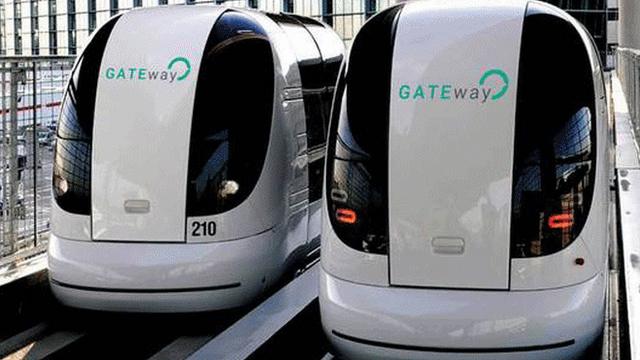London's first driverless cars based on Heathrow 'pods'
- Published

The new driverless pods will be similar to these shuttles used at Heathrow Airport
The first driverless cars to be tested on the streets of London will resemble the electric passenger shuttles currently in use at Heathrow Airport.
The group behind the project is currently adapting the pods for use on the roads.
It has yet to unveil the exact design but confirmed that the adapted vehicles will not run on dedicated tracks.
Greenwich is one of four places in the UK where driverless pods and public reaction to them are being tested.
Trials will also take place in Bristol, Coventry and Milton Keynes. The £8m project is jointly funded by government agency Innovate UK and industry.
The Greenwich Automated Transport Environment project - or Gateway - will see seven driverless pods tested on the pavements around the Greenwich Peninsula, where the O2 Arena is based, from July.
Routes are still being worked out but are likely to include residential areas, the North Greenwich underground station and businesses around the arena.
The so-called UltraPods currently in service at Heathrow carry passengers between the car park and Terminal 5. In the five years they have been in use, they have carried 1.5 million passengers and travelled 1.8 million miles (three million kilometres).
British backed
Westfield Sportscars, a British carmaker, will be responsible for manufacturing and testing of the pods. Heathrow Enterprise will design the software while a third British firm, Oxbotica, will provide mapping and other sensors to ensure the vehicles are safe.
The pods will have three months of testing, first with invited users and then with the general public. Each pod can carry six passengers but will require a steward to be present at all times to press the emergency button in the case of a problem.
The trial of the pods will reveal a wealth of data, Prof Nick Reed, academy director at Transport Research Laboratory which is leading the project, told the ┤¾¤¾┤½├¢.
"It will tell us whether people trust and accept these vehicles and how they would work as part of the urban landscape," he said.
"This vehicle has millions of miles under its belt and now we have to take it outside of the track and modify it for use on pavements."
'Milk float' design discarded
The pods will differ from an earlier demonstration where a shuttle designed by autonomous vehicle firm Phoenix Wings was on display.
An earlier design, which will not be adopted, was likened to a milk float
"That was perfect for the demonstration and we did consider using it but we had a procurement process and chose the design we have now," Prof Nick Reed said.
- Published11 February 2015
- Published3 December 2014